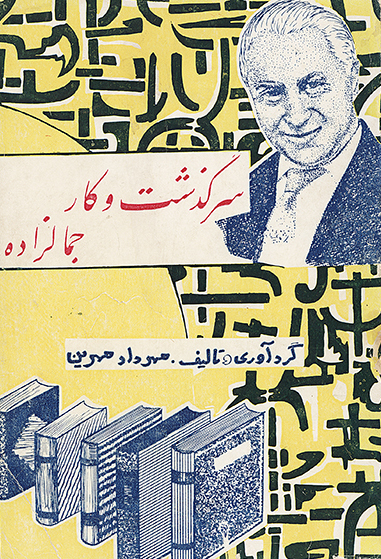20.10.2017
During the years of Armenian genocide many foreign diplomats, soldiers, missionaries, travellers in the Ottoman Empire have witnessed deportation and annihilation of Armenians living in the Ottoman Empire. Their memories contain valuable information about the policy of the Turkish authorities against Western Armenians and organization of deportations and mass killings. One of these eyewitnesses was a Persian prose writer Mohammad Ali Jamalzadeh.
Sayyed Mohammad-Ali Jamalzadeh was born in 1892 in Esfahan, in the family of an Islamic preacher. For attending French school he moved to Beirut (1908), then France ( 1910) and Switzerland, where he studied law at University of Lausanne and later at University of Burgundy in Dijon, France, where he received a Ph.D. in law. During 1915-1930 he lived in Berlin, where he worked for a Persian periodical published in Berlin, for a while he worked in the Iranian Embassy, was a member of The Union of Persian Nationalists in Germany, and in 1915 he founded the periodical of the Union. When British troops approached Baghdad, with two Swedish officers Jamalzadeh returned to Europe through Baghdad and Aleppo. His way was through Turkey, where he witnessed the terrible massacres of the Armenians by the Ottoman Government. About the tragic situation of caravans of displaced Armenians Jamalzadeh speaks in the book titled “Sargozasht va Qare Jamalzade” (Jamalzadeh’s life and work). Some years later, in 1917, he again referred to the events in an essay titled “Moshahedate shakssie man dar djange djahanie avval” (My personal reflections during the years of World War 1) published in Geneva. In his memories Jamalzadeh confirms, that his evidences are real, and he has personally witnessed the events. “In the evening I got to a village, where I stopped in an unpleasant café. And there, from that very moment I witnessed a number of cruel tortures of the Armenians by Turkish soldiers during the first years of World War One. As you may know the consequence was massacre of millions of Armenians”.
“For the way we took food and bog leader container. Our route was through the western coast of the Euphrates. As the water of the river was dirty, we took water in that. The Turkish government has massacred Armenians and thrown the corpses in the Euphrates. I have myself seen some corpses brought by the river”. When they went from Aleppo to Constantinople with the carts, they met a group of Armenians, whom Jamalzadeh described as “walking caravan of the Dead”. The writer describes that the Turkish rally gendarmes sent Armenians to death with an unbelievable cruelty. Hundreds of women, children, and men were shivering under the arms and throat strokes. “…From the very first inn we met many groups of Armenians sent to the destruction by the Turkish rally gendarmes. At first we were impressed by that, later we tried not to pay attention on it, and in reality it was difficult to see that. Thousand Armenian men, women and children not being able even to walk were pressured to continue their march with a stab and a weapon.
There was no young people among the male population, as turks had sent them to battlefield, or had killed them, suspecting that Armenians could take the side of the Russian army.
“Armenian girls shaved their heads because of the fear that Turks or Arabs could abduct them. Those who stayed behind the group, whatever was the reason, like fatigue, exhaustion or necessity of natural demand, anyway were killed. The cry of the mercy of the relatives was useless. Two or three Turkish gendarmes stabbed them like a sheep flock. From time to time, we met Armenians who had already died or died in the roadside”.
In Aleppo they stayed in “Princ” hotel, which was owned by an Armenian. During the same days Jemal Pasha also stayed in that hotel. An Armenian asked them to intercede for him to Jemal pasha not to deport him, but it didn’t help, and some days later they were informed that the owner of the hotel was deported to Beirut, were according to the writer, the Turks massacred all the Armenians. “There we have spent terrifying days, which were left in my memory as a nightmare. This is a nightmare which from time to time covers my soul, for different events, disturbs and afflicts me”.
“Later when I moved to Geneva and lived there, I learned that even in that time when millions of Armenians spent suffering days in Turkey, were shot or starved to death in inhabited deserts, with the help of Red Cross some Swiss families took Armenian orphans to Switzerland. Some children even were adopted by these families and they received education and upbringing.
And now there are many Armenians in Geneva, who were saved from the cruel destiny, and who are today well-known surgeons, engineers and architects. And that is the real humanism. God willing, those human beings are endowed with conscience and sound intelligence and always move forward in this way.
Geneva, May, 1972
Sayyed Mohammad-Ali Jamalzadeh”
A part from “My personal reflections during the World War 1” essay.
Mohammad-Ali Jamalzadeh died in 1997 in Geneva.

«Սարգոզաշթ վա քարե Ջամալզադե»(Ջամալզադեի կյանքն ու գործունեությունը), Թեհրան, 1963 թ.





